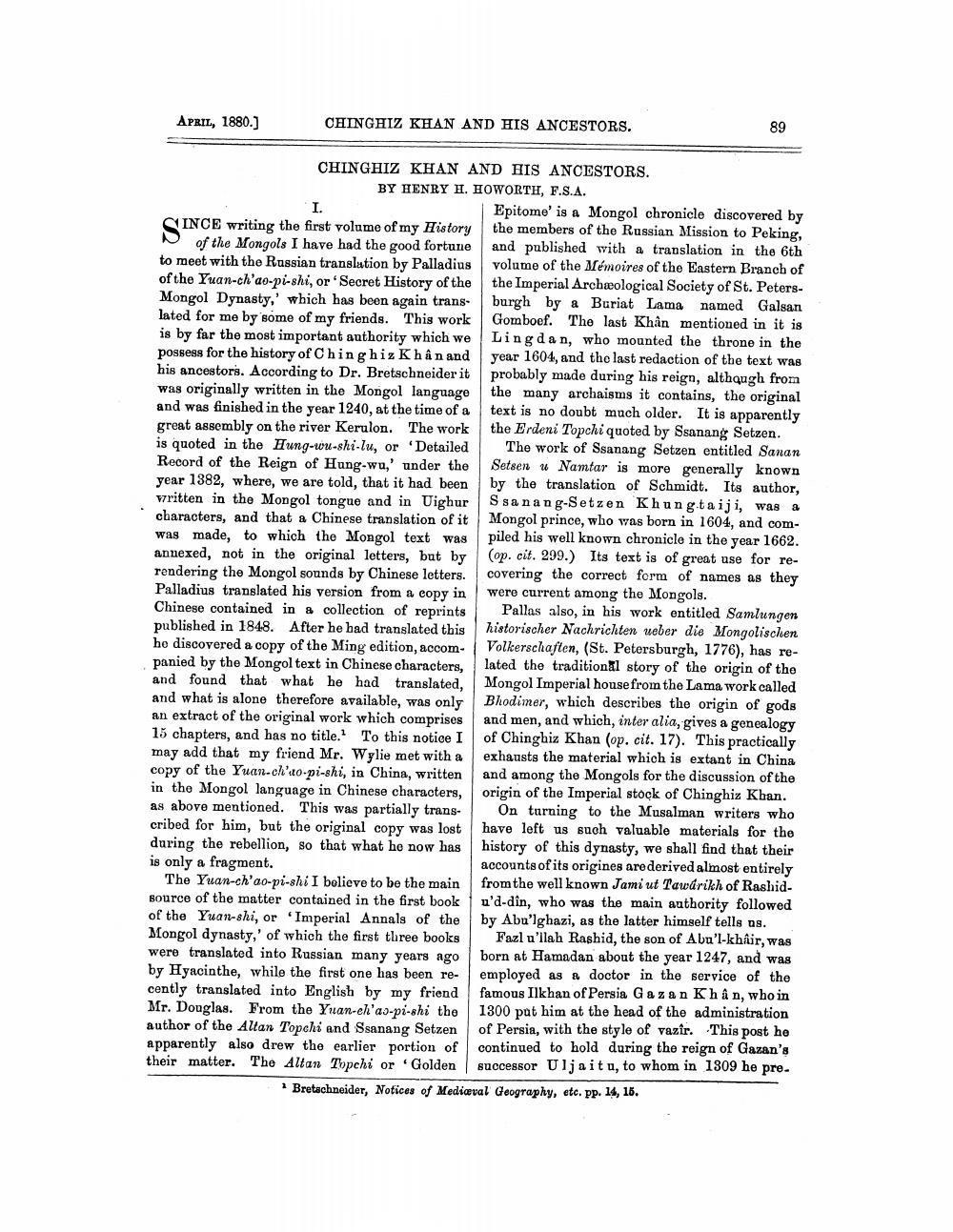________________
APRIL, 1880.]
CHINGHIZ KHAN AND HIS ANCESTORS.
CHINGHIZ KHAN AND HIS ANCESTORS. BY HENRY H. HOWORTH, F.S.A.
I.
SING
INCE writing the first volume of my History of the Mongols I have had the good fortune to meet with the Russian translation by Palladius of the Yuan-ch'ao-pi-shi, or 'Secret History of the Mongol Dynasty,' which has been again translated for me by some of my friends. This work is by far the most important authority which we possess for the history of Chin ghiz Khân and his ancestors. According to Dr. Bretschneider it was originally written in the Mongol language and was finished in the year 1240, at the time of a great assembly on the river Kerulon. The work is quoted in the Hung-wu-shi-lu, or 'Detailed Record of the Reign of Hung-wu,' under the year 1382, where, we are told, that it had been written in the Mongol tongue and in Uighur characters, and that a Chinese translation of it was made, to which the Mongol text was annexed, not in the original letters, but by rendering the Mongol sounds by Chinese letters. Palladius translated his version from a copy in Chinese contained in a collection of reprints published in 1848. After he had translated this he discovered a copy of the Ming edition, accompanied by the Mongol text in Chinese characters, and found that what he had translated, and what is alone therefore available, was only an extract of the original work which comprises 15 chapters, and has no title. To this notice I may add that my friend Mr. Wylie met with a copy of the Yuan-ch'ao-pi-shi, in China, written in the Mongol language in Chinese characters, as above mentioned. This was partially transcribed for him, but the original copy was lost during the rebellion, so that what he now has is only a fragment.
The Yuan-ch'ao-pi-shi I believe to be the main source of the matter contained in the first book of the Yuan-shi, or 'Imperial Annals of the Mongol dynasty,' of which the first three books were translated into Russian many years ago by Hyacinthe, while the first one has been recently translated into English by my friend Mr. Douglas. From the Yuan-eh'ao-pi-shi the author of the Altan Topchi and Ssanang Setzen apparently also drew the earlier portion of their matter. The Altan Topchi or Golden
89
Epitome' is a Mongol chronicle discovered by the members of the Russian Mission to Peking, and published with a translation in the 6th volume of the Mémoires of the Eastern Branch of the Imperial Archæological Society of St. Petersburgh by a Buriat Lama named Galsan Gomboef. The last Khân mentioned in it is Lingdan, who mounted the throne in the year 1604, and the last redaction of the text was probably made during his reign, although from the many archaisms it contains, the original text is no doubt much older. It is apparently the Erdeni Topchi quoted by Ssanang Setzen.
The work of Ssanang Setzen entitled Sanan Setsen u Namtar is more generally known by the translation of Schmidt. Its author, Ssanang-Setzen Khungtaiji, was a Mongol prince, who was born in 1604, and compiled his well known chronicle in the year 1662. (op. cit. 299.) Its text is of great use for recovering the correct form of names as they were current among the Mongols.
Pallas also, in his work entitled Samlungen historischer Nachrichten ueber die Mongolischen Volkerschaften, (St. Petersburgh, 1776), has related the traditional story of the origin of the Mongol Imperial house from the Lama work called Bhodimer, which describes the origin of gods and men, and which, inter alia, gives a genealogy of Chinghiz Khan (op. cit. 17). This practically exhausts the material which is extant in China and among the Mongols for the discussion of the origin of the Imperial stock of Chinghiz Khan.
On turning to the Musalman writers who have left us such valuable materials for the history of this dynasty, we shall find that their accounts of its origines are derived almost entirely from the well known Jami ut Tawarikh of Rashidu'd-din, who was the main authority followed by Abu'lghazi, as the latter himself tells us.
Fazl u'llah Rashid, the son of Abu'l-khair, was born at Hamadan about the year 1247, and was employed as a doctor in the service of the famous Ilkhan of Persia Gazan Khân, who in 1300 put him at the head of the administration of Persia, with the style of vazir. This post he continued to hold during the reign of Gazan's successor Ulja itu, to whom in 1309 he pre
Bretschneider, Notices of Mediaeval Geography, etc. pp. 14, 15.




